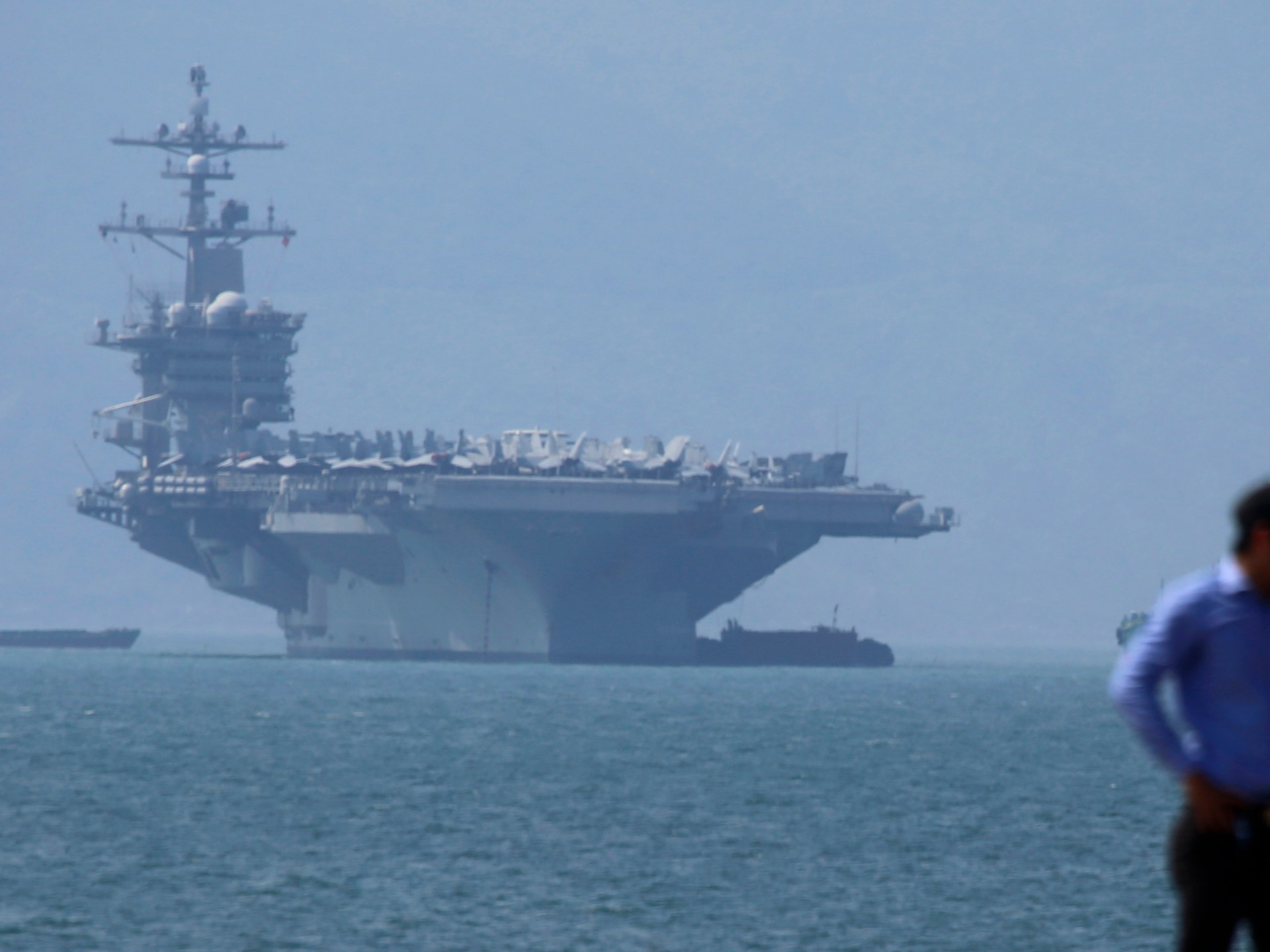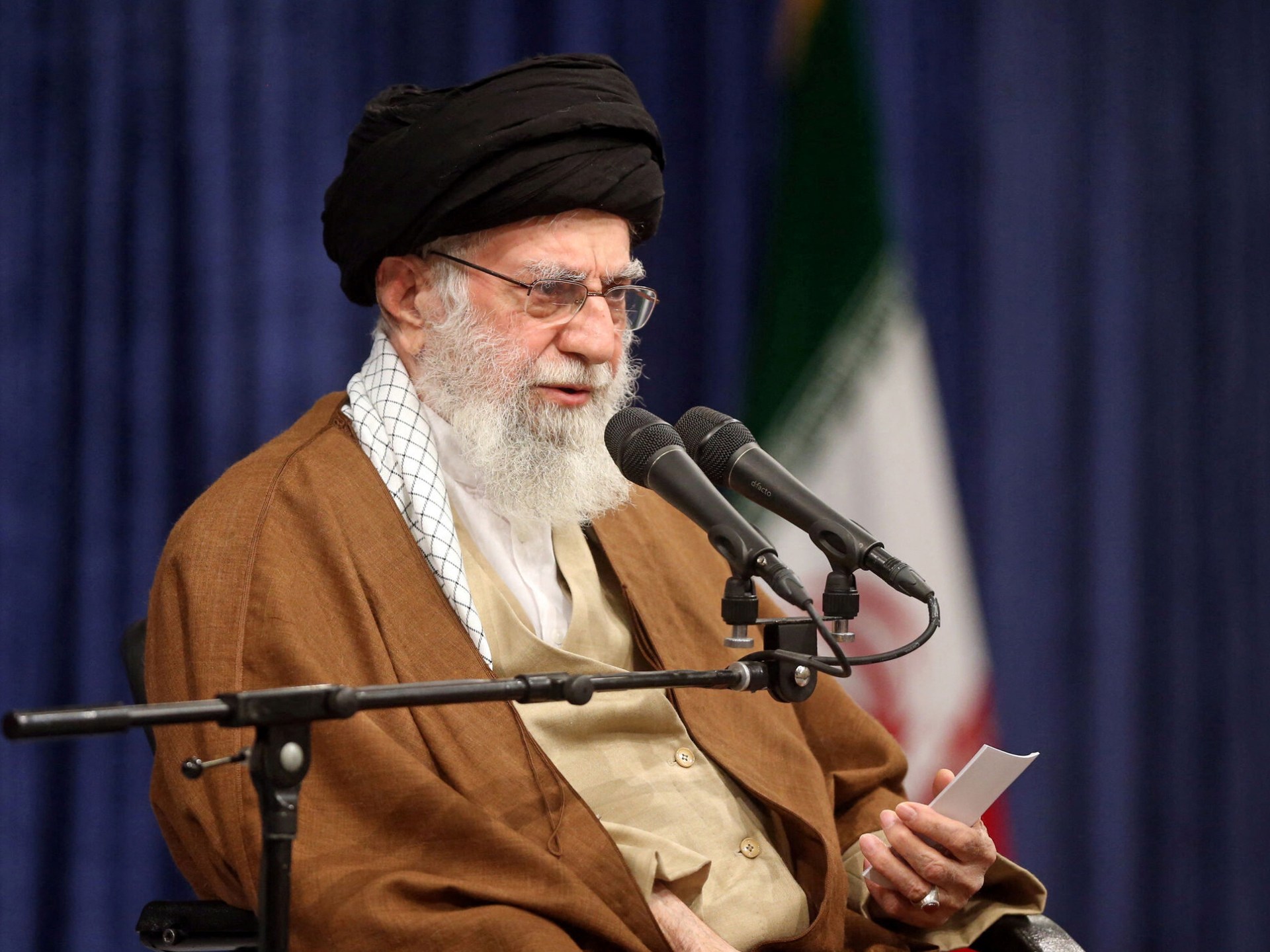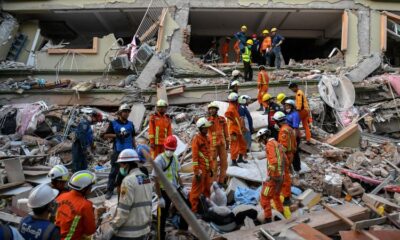Conflict Zones
US attacks kill 4 in Yemen as second aircraft carrier sent to Middle East | Military News

The Houthi Health Ministry says the latest US attack struck a water management building in the Hodeidah region.
Four people have been reported killed in attacks by the United States on Yemen’s Hodeidah region, the latest deadly strikes against Houthi forces as the US announced the deployment of a second aircraft carrier and more warplanes to the Middle East.
Anees Alasbahi, a spokesman for the Houthi health minister, said three people were confirmed killed in the US attack on Tuesday night but that the death toll was preliminary.
“The American attack, which targeted the water management building in the district of al-Mansouriyah in the governorate of Hodeidah with several strikes on Tuesday resulted in three deaths and two injuries, mostly employees,” Alasbahi said.
The Houthi-affiliated Al Masirah TV later reported that the death toll had risen to four. Local media reported that the Hajjah region in the northwest and Saada in the north had also been attacked.
The US has not confirmed that it carried out the attacks, which came after Al Masirah TV reported multiple US attacks hitting the Saada and Sanaa regions. There were no immediate reports of casualties from the Monday night attacks.
More than 60 people have been killed in Yemen since Washington launched a military offensive on March 15 against Houthi forces. The Yemeni armed group had threatened to renew attacking Israeli-linked shipping in the Red Sea in response to Israel’s breaking of the ceasefire in Gaza.
The Pentagon has also announced that it will increase the number of US aircraft carriers deployed in the Middle East to two, keeping one that is already stationed in the Red Sea and sending another from the Asia Pacific region.
The USS Carl Vinson aircraft carrier will join the USS Harry S Truman in the Middle East, the Pentagon said in a statement on Tuesday, adding that the US will also deploy additional military aircraft.
“The United States and its partners remain committed to regional security in the CENTCOM (Central Command area of responsibility) and are prepared to respond to any state or non-state actor seeking to broaden or escalate conflict in the region,” the Pentagon said.
Houthi forces also claimed late on Tuesday that they had fired a number of cruise missiles and drones at US ships in the Truman aircraft carrier group. It was the third strike against US military vessels in 24 hours, the Houthis said in a statement carried by Al Masirah TV.
Though the Pentagon made no mention of specific aircraft being sent to the region, at least four B-2 bombers have relocated to a US-British military base on the Indian Ocean island of Diego Garcia, according to US officials speaking on condition of anonymity with the Reuters news agency. The Diego Garcia base is within striking distance of Yemen and Iran, experts say.
The US military’s Strategic Command has declined to say how many B-2s have reached Diego Garcia and noted that it does not comment on exercises or operations involving the bombers.
The deployment of a second aircraft carrier and B-2 bombers – there are only 20 of the latter in the Air Force’s inventory so they are usually used sparingly – comes after US President Donald Trump said that strikes on Houthi fighters would continue until they are no longer a threat to shipping.
Trump has also ramped up rhetoric towards Tehran, threatening on Sunday that “there will be bombing” if Iran does not reach a deal with Washington, on his terms, on Iran’s nuclear programme.
Iran’s Supreme Leader Ayatollah Ali Khamenei said on Monday that the US would receive a strong blow if Trump followed through with his threats.
The aerospace commander of Iran’s Revolutionary Guard, Amirali Hajizadeh, reminded Washington that it had bases in the Middle East, saying, “They are in a glass house and should not throw stones”.
The Tehran Times also reports that Iranian forces have readied missiles “with the capability to strike US-related positions” due to Trump’s threats.
Conflict Zones
How much will Trump’s new tariffs hurt other countries and US consumers? | News

On Wednesday, United States President Donald Trump imposed sweeping reciprocal tariffs on the US’s trading partners.
The day was termed “Liberation Day” by Trump, who signed an executive order imposing a flat 10 percent tariff on almost all nations and then additional tariffs on those countries that the US accuses of charging higher levies on American goods.
The levies sent shock waves through global markets and prompted criticism from world leaders. China and the European Union have already responded with retaliatory measures, signalling the risk of a global trade war.
China’s Ministry of Commerce called on Washington to cancel the tariffs. “There is no winner in a trade war, and there is no way out for protectionism,” the ministry said in a statement.
The 10 percent flat tariffs come into force on April 5, while the other tariffs will come into effect on April 9.
What are the new tariffs announced?
Trump has targeted roughly 60 countries with customised reciprocal tariffs. These are countries that have been singled out as ones that charge higher levies on US goods. The steeper rates apply to both major US trading partners and smaller economies – and allies and rivals alike.
China has been hit with a 54 percent tariff, including 20 percent levies from earlier; Lesotho faces a 50 percent tariff; Cambodia 49 percent; and neighbouring Vietnam 46 percent.
“The hike in tariffs was more aggressive than expected,” Lynn Song, chief economist for Greater China at Dutch bank ING, told Al Jazeera.
“Many were expecting a range of 10-20 percent tariffs. This sort of aggressive move will probably risk some retaliation from the bigger players, though smaller countries could choose to try and negotiate for a lower rate.”
The EU has also been hit with a 20 percent tariff.
Baseline tariffs of 10 percent have been applied to all imports coming to the US. Some countries facing 10 percent levies are the United Kingdom, Australia, Singapore, Brazil and the United Arab Emirates.
There will be no additional tariffs on Canada and Mexico – both countries are already subject to 25 percent tariffs, except for products covered by a free trade deal with the US.
Explore the table below to see which countries have been hit the least and most.
Which countries export the most to the US?
In 2024, Mexico exported $505.9bn of goods to the US, according to the US International Trade Administration.
This was followed by China, which exported $438.9bn; Canada, $412.7bn; Germany $160.4bn; and Japan $148.2bn.
Which countries will be most affected?
While Trump did not impose extra tariffs on Canada or Mexico, these countries are the most likely to be affected by US levies, given the high percentage of exports that go to the US.
In 2023, 77.6 percent of Canada’s total exports went to the US, according to data from the United Nations Comtrade. Mexico’s total exports to the US were 79.6 percent.
By contrast, while the US is the EU’s largest export destination, the bloc has many other countries that buy its products: In 2023, the US accounted for less than 20 percent of the EU’s exports, according to Comtrade.
Similarly, while a heavy tariff is being applied to Chinese products, only 14.8 percent of Chinese exports went to the US in 2023. So while the US was China’s biggest export market that year, China’s vast portfolio of other export destinations – including Japan, Germany, India and Mexico – means that it might hurt less than Canada or Mexico.
Still, the tariffs could influence how China approaches future trade with the US, according to experts.
“Escalation of tariffs and a continuation of unilateral measures could deepen the erosion of trust in the global trade system, further pushing China to diversify its partners and reduce reliance on the US market,” Carlos Lopes, a Chatham House associate fellow with expertise in international trade and China, told Al Jazeera back in January.
How will this affect US consumers?
In 2023, the US imported $3 trillion worth of goods – about $1 trillion more than it exported.
US consumers are already facing higher car prices following Trump’s 25 percent levies on all autos and auto parts coming into the US, which came into effect on Wednesday, April 2. Since the tariffs also apply to auto parts, cars manufactured in the US using imported parts will become more expensive.
“The increased costs would cause significant disruption throughout the supply chain and, perhaps, most importantly, lead to significant price increases to the cost to American consumers for vehicles,” the Detroit Regional Chamber and MichAuto, an automotive and mobility association, said in a letter, the Reuters news agency reported.
On Thursday, New Zealand Prime Minister Christopher Luxon responded to the 10 percent tariffs imposed on the country: “It ends up driving higher prices for US consumers, higher inflation, slows down growth and, as a result, that puts real pressure in across the world.”
Conflict Zones
Trump says he thinks Iran wants direct talks with US | Donald Trump News

US president says Iran initially wanted talks through intermediaries, but he thinks Tehran has changed its position.
Washington, DC – Donald Trump has suggested that Iran may agree to direct talks with the United States despite the intensifying tensions and back-and-forth threats between the two countries.
Speaking to reporters on Thursday, the US president appeared optimistic about the prospect of face-to-face diplomacy with Tehran.
“I think it’s better if we have direct talks,” he said. “I think it goes faster, and you understand the other side a lot better than if you go through intermediaries. They wanted to use intermediaries. I don’t think that’s necessarily true any more.”
Last month, Trump sent a letter to the Iranian leadership calling for negotiations to address Iran’s nuclear programme. The US president has also been regularly threatening Iran with military strikes.
Tehran has rejected the prospect of direct talks with Washington but said it is open to indirect diplomacy.
It is not clear whether Iran has indeed changed its stance or if Trump is speculating about Tehran’s position.
The US administration has been piling up sanctions against Iran with the aim of completely choking off the country’s oil exports – particularly to China.
In 2018, during his first term as president, Trump nixed a multilateral deal that saw Iran scale back its nuclear programme in exchange for the lifting of international sanctions against its economy.
Tehran maintains that it is not seeking a nuclear weapon. Israel, the top US ally in the region, is widely believed to have an undeclared nuclear arsenal.
Since returning to office in January, Trump has promised to bring “peace” to global conflicts – though he has addressed Iran with a mix of public diplomatic overtures and bombastic warnings.
“If they don’t make a deal, there will be bombing,” he said last week.
Iranian officials have responded with their own threats, suggesting that, if the country is attacked, it will strike back against US troops and interests in the Middle East.
“The US must know that, when facing Iran, threats will never achieve anything,” Iranian Supreme Leader Ayatollah Ali Khamenei said last month, according to Iran’s Tasnim News Agency.
“The US and others must know that, if they commit any malicious act against the Iranian nation, they will receive a severe blow.”
But Tehran’s position in the region appears to have weakened amid the ongoing war in Gaza and beyond.
Israel, for example, killed the top political and military leadership of Lebanon’s Hezbollah, Iran’s once-fearsome ally. Iran lost another key partner after armed opposition groups toppled Syrian President Bashar al-Assad in December of last year.
“I think they’re concerned, I think they feel vulnerable, and I don’t want them to feel that way,” Trump said on Thursday, referring to Iran.
Conflict Zones
Russia-Ukraine war: List of key events, day 1,134 | Russia-Ukraine war News

These are the key events on day 1,134 of Russia’s war on Ukraine.
These are the key events from Wednesday, April 2:
Fighting
One person was killed and two others injured in a Russian overnight attack on southeast Ukraine’s Zaporizhia region, Regional Governor Ivan Fedorov said.
A Russian ballistic missile strike on Ukraine’s Kryvyi Rih killed at least four people and injured 14 others, including two children, Ukrainian authorities said.
An infant, a seven-year-old boy and six others were also injured in a drone attack on Ukraine’s Kharkiv region, said Oleh Syniehubov, the region’s governor. Kharkiv’s Mayor Ihor Terekhov said 15 drone strikes were carried out in the region.
At least 60 people were forced to evacuate from their homes in the Russian city of Kursk after falling debris from intercepted Ukrainian drones hit their apartment buildings, acting governor, Alexander Khinshtein, said.
Russia’s state news agencies TASS and RIA Novosti report that Russian forces destroyed 93 Ukrainian drones overnight, most of which were destroyed over the Kursk region.
The Ukrainian air force said it shot down 41 of 74 Russian drones launched towards Ukraine overnight. Another 20 drones failed to reach their targets due to electronic jamming measures, the air force said.
Ukrainian President Volodymyr Zelenskyy said nearly 4,000 people were left without electricity after a Russian drone hit a substation in Ukraine’s northeastern Sumy region, and artillery fire damaged a power line in the central Dnipropetrovsk region.
Moscow’s Ministry of Defence also accused Kyiv of hitting Russian energy facilities twice in the past 24 hours despite a mutual moratorium on energy strikes brokered by the United States.
Germany’s Deutsche Presse-Agentur (DPA) news agency reported that Russia had destroyed one of its own dams in the Belgorod border region using an aerial bomb. The reason for the dam’s destruction was not given.
Oil and Gas
Russia said it ordered the closure of the Black Sea port terminal handling Kazakhstan’s oil exports and US giants Chevron and Exxon Mobil, after two inspections on moorings for vessels at the terminals.
Ceasefire
Russia and Ukraine accused each other of breaching the US-brokered moratorium on energy strikes after both countries reported damage to energy facilities due to alleged violations by both sides.
Politics and Diplomacy
Eleven Ukrainian children were returned to Kyiv from Russia and Russian-occupied Ukraine under the Bring Kids Back UA initiative, President Zelenskyy’s chief of staff, Andriy Yermak, said.
The Kremlin said it is “possible” that Russian envoy Kirill Dmitriev will visit the US and said contact with Washington was ongoing. The Reuters news agency reported that Dmitriev is expected in Washington this week for talks with US President Donald Trump’s administration.
-

 Africa1 day ago
Africa1 day agoUS president announces global tariffs, including on 51 African nations
-

 Lifestyle2 days ago
Lifestyle2 days agoShingles is awful, but there may be another reason to get vaccinated. It may fight dementia
-

 Europe2 days ago
Europe2 days agoLive updates: Trump announces sweeping new tariffs on imports on ‘Liberation Day’
-

 Asia2 days ago
Asia2 days agoMyanmar’s military government announces temporary ceasefire to aid quake efforts
-

 Middle East2 days ago
Middle East2 days agoIsrael’s Netanyahu heads to Hungary in defiance of ICC arrest warrant | Gaza News
-

 Education2 days ago
Education2 days agoA trans teacher in Texas resigns after being targeted by conservatives online
-

 Sports2 days ago
Sports2 days agoDaria Kasatkina: Russian-born tennis player ‘didn’t have much choice’ over switching allegiances to Australia
-

 Education2 days ago
Education2 days agoNashville school shooter sought fame in 2023 attack that left 6 dead, report finds




